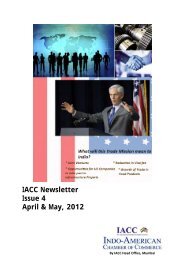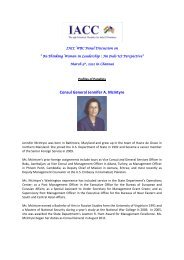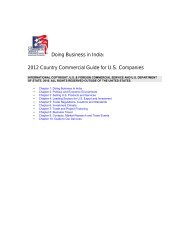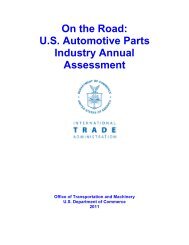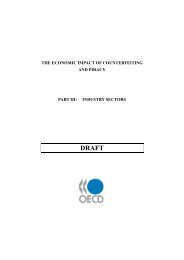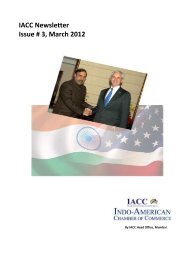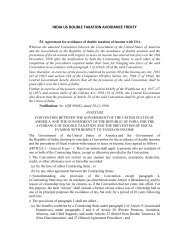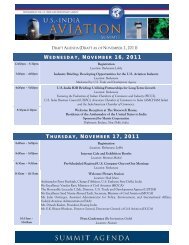Importing into the United States - Indo-American Chamber Of ...
Importing into the United States - Indo-American Chamber Of ...
Importing into the United States - Indo-American Chamber Of ...
You also want an ePaper? Increase the reach of your titles
YUMPU automatically turns print PDFs into web optimized ePapers that Google loves.
included in computed value only to <strong>the</strong> extent<br />
that such value has been charged to <strong>the</strong> producer.<br />
Packing Costs. The cost of all containers and<br />
coverings of whatever nature, and of packing,<br />
whe<strong>the</strong>r for labor or material, used in placing<br />
merchandise in condition and packed ready for<br />
shipment to <strong>the</strong> <strong>United</strong> <strong>States</strong> is included in<br />
computed value.<br />
Under computed value, “merchandise of<br />
<strong>the</strong> same class or kind” must be imported from<br />
<strong>the</strong> same country as <strong>the</strong> merchandise being<br />
appraised and must be within a group or range<br />
of goods produced by a particular industry or<br />
industry sector. Whe<strong>the</strong>r certain merchandise is<br />
of <strong>the</strong> same class or kind as o<strong>the</strong>r merchandise<br />
will be determined on a case-by-case basis.<br />
In determining usual profit and general<br />
expenses, sales for export to <strong>the</strong> <strong>United</strong> <strong>States</strong><br />
of <strong>the</strong> narrowest group or range of merchandise<br />
that includes <strong>the</strong> merchandise being<br />
appraised will be examined, providing that <strong>the</strong><br />
necessary information can be obtained.<br />
NOTE: As a point of contrast, under deductive<br />
value, “merchandise of <strong>the</strong> same class or kind”<br />
includes merchandise imported from o<strong>the</strong>r<br />
countries besides <strong>the</strong> country from which <strong>the</strong><br />
merchandise being appraised was imported.<br />
Under computed value, “merchandise of <strong>the</strong><br />
same class or kind” is limited to merchandise<br />
imported from <strong>the</strong> same country as <strong>the</strong> merchandise<br />
being appraised.<br />
VALUE IF OTHER VALUES<br />
CANNOT BE DETERMINED<br />
If none of <strong>the</strong> previous five values can be<br />
used to appraise <strong>the</strong> imported merchandise,<br />
<strong>the</strong>n <strong>the</strong> customs value must be based on a<br />
value derived from one of <strong>the</strong> five previous<br />
methods, reasonably adjusted as necessary. The<br />
value so determined should be based, to <strong>the</strong><br />
greatest extent possible, on previously determined<br />
values. In order for Customs to consider<br />
an importer’s argument regarding appraisement,<br />
<strong>the</strong> information upon which <strong>the</strong> argument<br />
is based must be made available to Customs,<br />
whe<strong>the</strong>r it was generated by a foreign or<br />
domestic source. Some examples of how <strong>the</strong><br />
o<strong>the</strong>r methods can be reasonably adjusted are:<br />
Identical Merchandise (or Similar Merchandise).<br />
1. The requirement that <strong>the</strong> identical merchandise<br />
(or similar merchandise) should<br />
be exported at or about <strong>the</strong> same time as<br />
<strong>the</strong> merchandise being appraised could be<br />
flexibly interpreted.<br />
2. Identical imported merchandise (or similar<br />
imported merchandise) produced in a<br />
country o<strong>the</strong>r than <strong>the</strong> country of exportation<br />
of <strong>the</strong> merchandise being appraised<br />
could be <strong>the</strong> basis for customs valuation.<br />
3. Customs values of identical imported merchandise<br />
(or similar imported merchandise)<br />
already determined on <strong>the</strong> basis of<br />
deductive value and computed value<br />
could be used.<br />
Deductive Method. The 90-day requirement<br />
may be administered flexibly (19 CFR<br />
152.107(c)).<br />
The origin of merchandise that is imported<br />
<strong>into</strong> <strong>the</strong> customs territory of <strong>the</strong> <strong>United</strong> <strong>States</strong><br />
can affect <strong>the</strong> rate of duty, entitlement for special<br />
programs, admissibility, quota, antidumping<br />
or countervailing duties, procurement<br />
by government agencies and marking<br />
requirements. In order to determine a product’s<br />
32. RULES OF ORIGIN<br />
country of origin, <strong>the</strong> importer should consult<br />
<strong>the</strong> applicable rules of origin.<br />
There are two basic types of rules of<br />
origin: non-preferential and preferential. Nonpreferential<br />
rules generally apply in <strong>the</strong><br />
absence of bilateral or multilateral trade agreements.<br />
Preferential rules are applied to merchandise<br />
to determine its eligibility for special<br />
treatment under various trade agreements or<br />
special legislation such as <strong>the</strong> Generalized<br />
System of Preferences (GSP), <strong>the</strong> North Amer-<br />
IMPORTING INTO THE UNITED STATES<br />
63



